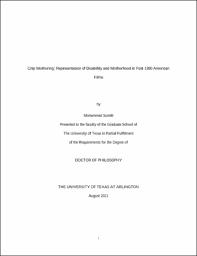
ATTENTION: The works hosted here are being migrated to a new repository that will consolidate resources, improve discoverability, and better show UTA's research impact on the global community. We will update authors as the migration progresses. Please see MavMatrix for more information.
Show simple item record
| dc.contributor.advisor | Ingram , Penelope | |
| dc.creator | Sumili, Mohammed Ali H | |
| dc.date.accessioned | 2021-09-14T16:12:30Z | |
| dc.date.available | 2021-09-14T16:12:30Z | |
| dc.date.created | 2021-08 | |
| dc.date.issued | 2021-08-30 | |
| dc.date.submitted | August 2021 | |
| dc.identifier.uri | http://hdl.handle.net/10106/30022 | |
| dc.description.abstract | Most scholarship on the topic of disability and motherhood tends to be of an empirical nature common to social, education, and psychology studies (Landsman 2008; Wilson and Cellio 2011, Filax and Taylor 2014). Despite the appearance of movies, novels and especially memoirs that deal with the subject, disability as it engages with motherhood has received scarce attention by feminist, motherhood, and disability scholarship (Prilleltensky 2004; Landsman 2008). Existing literature indicates a gap in studying the joint representation of mothers and disability.
This study aims to address this gap by analysis of a selection of post-1980 American movies. Concentrating on the relation between mother and child as “interactional performance" (Walsh 28), I examine the movies' treatment of mothers' mediation of disability while they raise and socialize children to meet societal expectations. Grounded in a feminist disability framework, this research argues that disability enhances, rearticulates, troubles, and undermines dominant concepts of mother/hood as an ideology, experience, and subjectivity. Moreover, it proposes a theorization of crip mothering as a form of mothering informed by disability as difference and an alternative way of being.
Scholarly literature concurs that popular cultural images have an ideological force in formulating public conceptual perceptions of the world (Kaplan 1992; Hall 1997; Haller 2010). Susan Bordo, deploying Foucault, contends that popular culture causes the internalization of an intense self-surveillance that sustains the efficacy of cultural and societal proscriptions. The enduring stereotypical representations of disability and motherhood marginalize and disempower mothers as well as people with disabilities. Despite their ubiquitous presence in films, they are always assigned subordinate roles (Kaplan 1992; Garland-Thomson 1997). Both are measured against a predominant norm that precludes their participation in social and economic life. Therefore, mothers and people with disabilities serve as backgrounds against which able-bodied and masculine bodies assert their subject positions. | |
| dc.format.mimetype | application/pdf | |
| dc.language.iso | en_US | |
| dc.subject | Disability | |
| dc.subject | Motherhood | |
| dc.subject | Representation | |
| dc.title | Crip Mothering: Representation of Disability and Motherhood in Post-1980 American Films | |
| dc.type | Thesis | |
| dc.degree.department | English | |
| dc.degree.name | Doctor of Philosophy in English | |
| dc.date.updated | 2021-09-14T16:12:31Z | |
| thesis.degree.department | English | |
| thesis.degree.grantor | The University of Texas at Arlington | |
| thesis.degree.level | Doctoral | |
| thesis.degree.name | Doctor of Philosophy in English | |
| dc.type.material | text | |
| dc.creator.orcid | 0000-0002-4692-0908 | |
Files in this item
- Name:
- SUMILI-DISSERTATION-2021.pdf
- Size:
- 1.004Mb
- Format:
- PDF
This item appears in the following Collection(s)
Show simple item record


